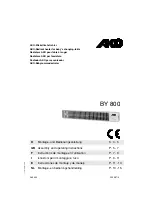
Mighty Therm LO-NOx Volume Water Heater
Page 11
Heat
Flow
Pressure*
Water Temp
Exch.
Water
Rate
Drop
Rise
Model
Passes
Category
gpm
L/s
ft.
m
°
F
°
C
250
2
Soft
22
1.4
5.8
1.8
18
10
Normal
34
2.1
11.2
3.4
12
7
Hard
46
2.9
19.1
5.8
9
5
400
2
Soft
34
2.1
13.3
4.1
19
11
Normal
34
2.1
13.3
4.1
19
11
Hard
46
2.9
23.4
7.1
14
8
*Pressure drop includes head loss of heat exchanger and through 30 feet (9.1 m) of pipe and normal fittings when heater
is installed with storage tank. Pipe and fittings are assumed to be 1-1/2 inch (38 mm).
Remote Temperature
Control for Heater
Main Circulating Loop
(With Own Pump)
Water Maintained
Less Than 110°F (43°C)
To
Drain
Heater
Adjustment Procedure
1.
Turn on heater and open gate
valves A and B.
2.
After 15 minutes, read T
1
.
3.
If T
1
is less than 110°F (43°C),
slowly close valve B until T
1
climbs to 110°F (43°C).
4.
If T
1
is greater than 110°F (43°C),
slowly close valve A until T
1
drops to 110°F (43°C).
5.
Check after 5 minutes
operation and make final
adjustments.
Figure 21. Cold Water Application.
Table 4. Pump Performance Requirements.
Flow
Switch
High-Limit
Dry Well
Pressure
Relief Valve
Figure 22. Pressure Relief Valve.
The factory provided pump on the PW heaters is
sized to provide proper circulation through the heater,
and through the heater-to-tank circulation loop (see
Figures 21, 23 and 24).
If the heater-to-tank circulation loop does not
contain more than 6 elbows or 30 feet (9.1 m) of pipe,
the minimum pipe fitting should be 1-1/2 inches (38
mm). If the loop does contain more than 6 elbows or
30 feet (9.1 m) of pipe, the minimum size should be
2 inches (51 mm).
2.6.5 Pressure Buildup in Water System
The water utility supply meter may contain a
check valve, back flow preventer, or water pressure
reducing valve that will create a closed water supply
system. Contact the water supplier or local plumbing
inspector on how to control this situation.
During the heating cycle of the heater, the water
expands creating a pressure buildup in the water
system. The pressure relief valve may discharge hot
water under these conditions, causing a loss/waste of
energy and a buildup of lime on the relief valve seat.
NOTE: Do not plug the relief valve.
There are two methods to prevent the relief valve
from discharging hot water in a closed water system:
1.
Install a pressure relief valve on the cold water
supply line. Make sure that the discharge of this
OUT OF
PRODUCTION












































